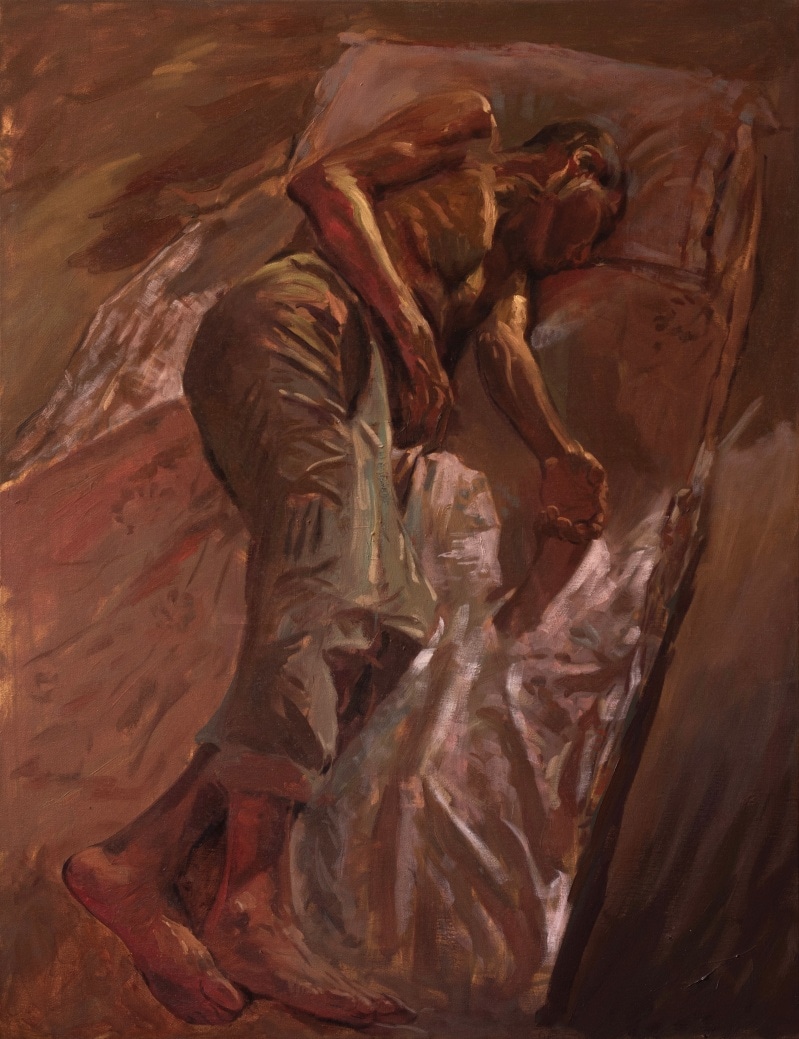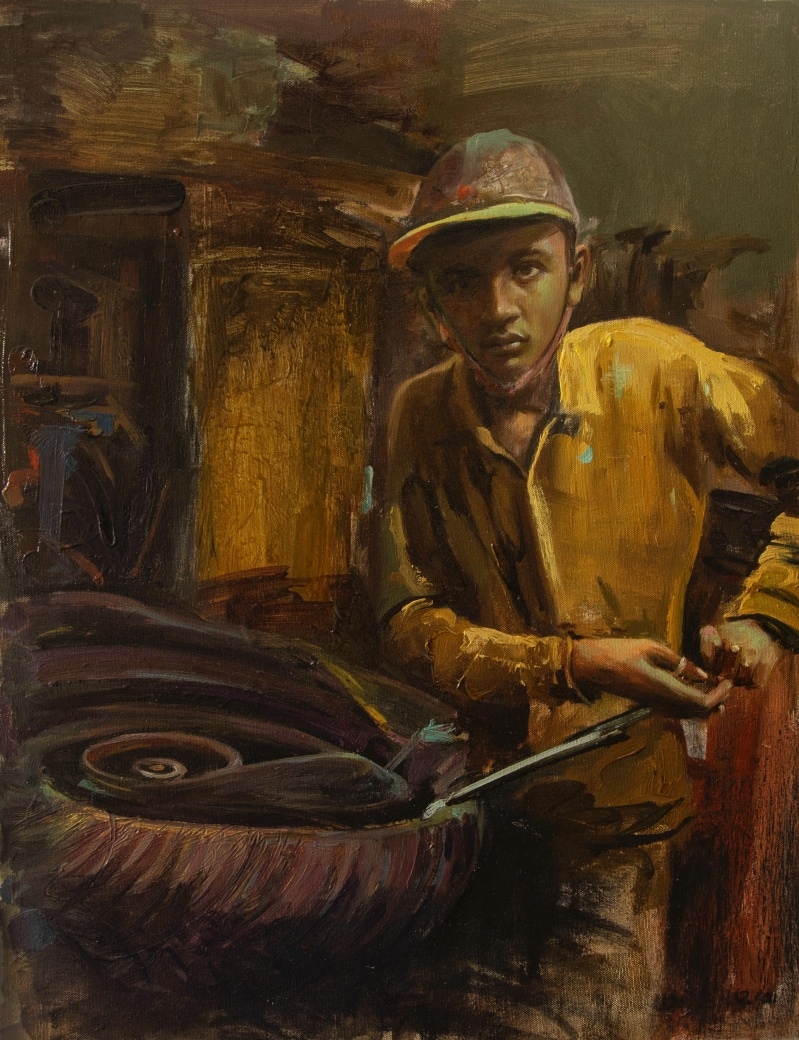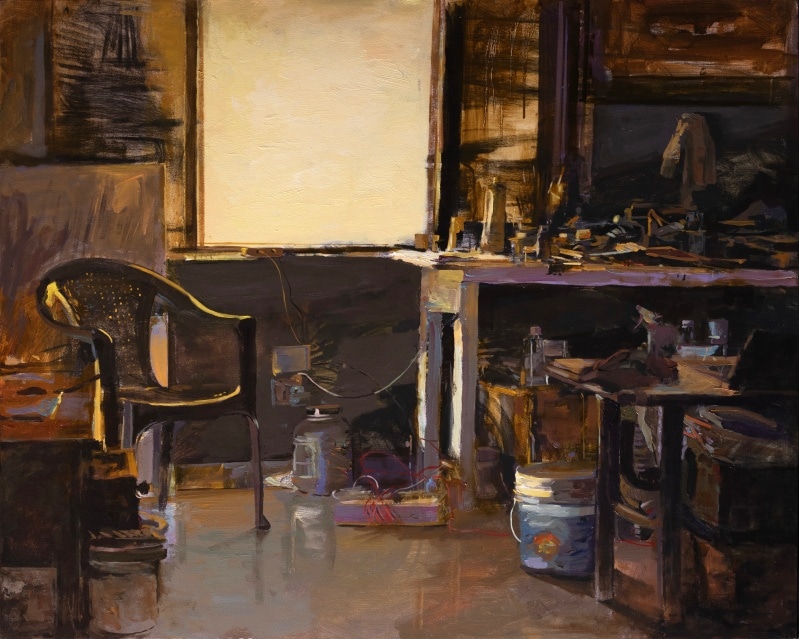A young boy sitting against a backdrop dominated by fast-paced machinery, his contemplating, sombre eyes indicate an infinitude of thoughts; an old man with visible chest bones on a canvas of an oil painting, sleeping after the day ends, his bald head drooping onto his shoulder; a giant shovelling machine that represents the complex work and thoughts of daily-wage earners are all part of Shubhendu Sarkar’s solo exhibition titled ‘Tracing the Unseen’ at the India International Centre (IIC) Annexe, New Delhi. The show, which closes on July 18, captures the unseen realities of hardworking people who often shape our lives.

Our cities and the modern techno-industrial society, saturated with social media and advertisements, put on a facade of luxury and sophistication, showing only the best of what one can dream of. In this dynamic environment of hustle-culture, shopping frenzy and extravaganza, what often goes unrecognised and unappreciated are some of the simple souls and their physical labour that continues from dawn-till-dusk, often in a chaotic and dark environment.
Shubhendu draws his subjects from the people he sees and interacts with daily —individuals who often fade into the background. Capturing fleeting moments from these familiar domestic spaces, he tries to plant a seed of emotional truth or awareness within the psyche of aesthetes. He says, “Many of these paintings are born from my experiences of interacting with people when I visit in Delhi. Be it the young boy repairing a bicycle puncture or a man repairing a machine. For instance, some of the drawings are of my father. I first draw a rough sketch on paper with graphite or charcoal, then, after procuring a fair idea about the picture, I execute it with oil on canvas.”
 Silent Hands, Heavy Task (Shubhendu Sarkar)
Silent Hands, Heavy Task (Shubhendu Sarkar)
As an artist, Shubhendu’s eyes fall on these seen-yet-unseen actualities of the world and through his paintings, he creates a deeper sense of empathy and perception of our surroundings. “My surroundings are my inspiration. An artist doesn’t look at things like everyone else. A simple, everyday situation can be put onto a canvas. When a connoisseur sees the image, as it is deeply connected to humanity, inside his heart he will feel ‘wow’, have that sense of wonder. That’s all I want,” he says.
In the IIC Annexe Art Gallery Shubhendu has placed two oil paintings together, titled ‘The Carpenter’s Code’ and ‘Where the Silence Paints’. These artworks without a human subject, speak volumes about the artist and the hours spent in solitary labour. ‘The Carpenter’s Code’ is filled with wooden logs, equipment placed disorderly on the table and slivers of wood spilled on the ground. Similarly, ‘Where Silence Paints’, is of Shubhendu studio, which contains a canvas at the centre, an empty chair on the left and tables on the right with almost all his painting equipment splattered on it.
These paintings depict the spaces of two artists working in different mediums, subtly representing the inner landscapes of creative individuals. Shubhendu who believes that every medium has its own advantages, finds his deepest joy in working with graphite and charcoal on paper and oil painting.
Story continues below this ad
 Where Silence Speaks (Shubhendu Sarkar)
Where Silence Speaks (Shubhendu Sarkar)
In his other paintings, one sees boys engaged in hard physical labour; cycle workshops where wheels, chains and steel splinters create a chaotic mess; a common man sitting in the middle of machines and welding, in the afternoon. Shubhendu’s craft attains excellence by converting these mundane moments and people into artistic truths that invite a spectator to pause and contemplate. “The job of the artist or his highest hope should be what he can contribute to the art world. Not only painters, if you look at singers like Nusrat Fateh Ali Khan or Mohammed Rafi, they have died but their songs live on. The job of a true artist is to produce such works that can surpass the passage of time,” says Shubhendu, who graduated from College of Art, New Delhi in 2020.
Shubhendu has received numerous awards, including the Himachal State Museum Award in Painting and has been part of multiple exhibitions throughout India. “The art of drawing is no longer separate from who I am. It’s how I process and understand the world around me, how I communicate what remains unspoken. My art is not decorative, it’s lived, it’s the solitude of practice. It’s how I build empathy for those whose realities I translate on paper,” he says.
Deepak Rajeev is an intern with The Indian Express
